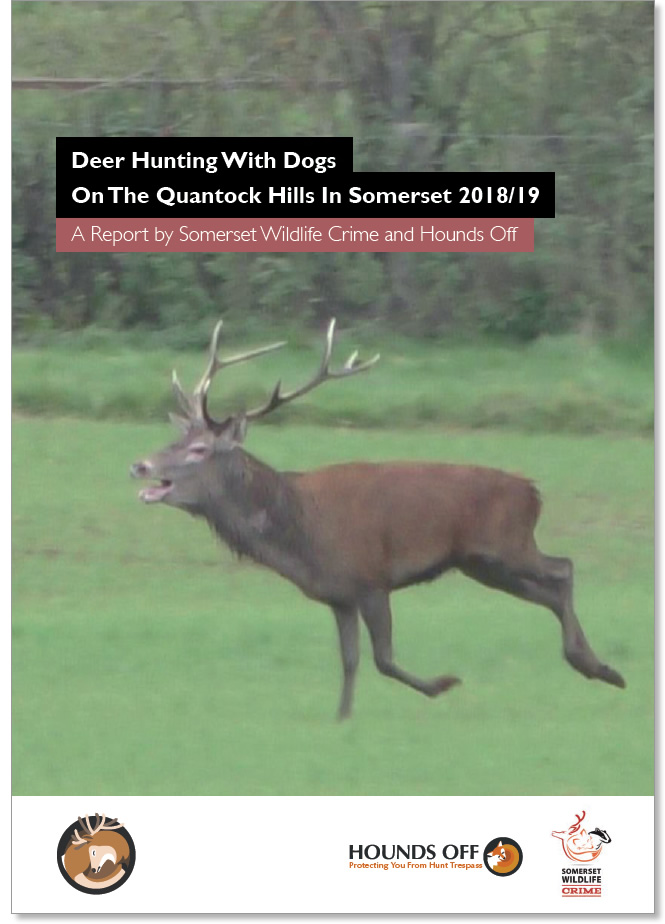25th August 2019
Deer Hunting With Dogs On The Quantock Hills In Somerset 2018/19; A Report by Somerset Wildlife Crime and Hounds Off
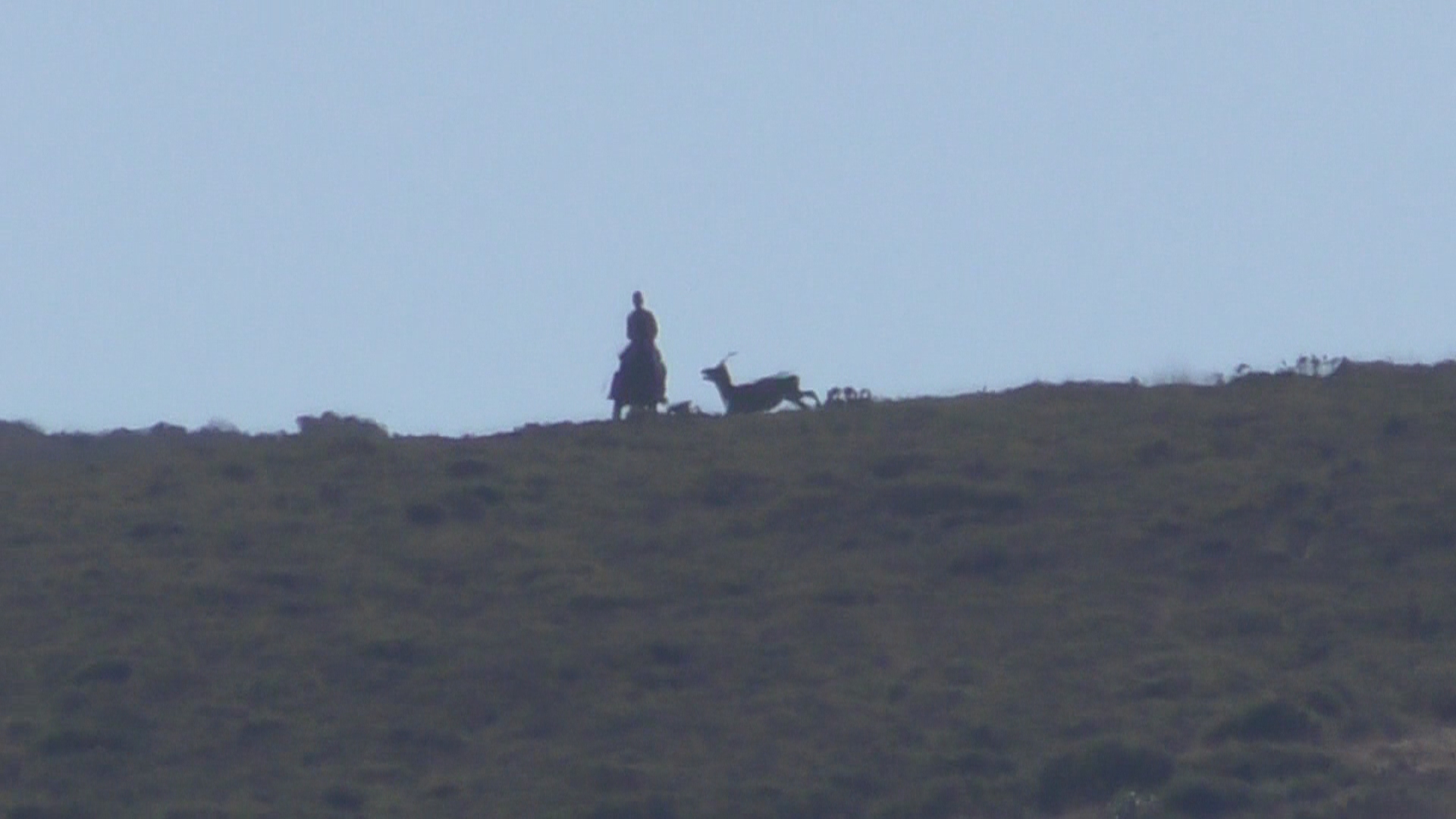 Closing in for the kill. Quantock Stag Hounds, 11 April 2019.
Closing in for the kill. Quantock Stag Hounds, 11 April 2019.
Click/tap the cover image below, or click here to download and read a PDF version of our groundbreaking Report.
15th March 2019
Somerset Churchyard Fox Hunt Excuses Rebutted
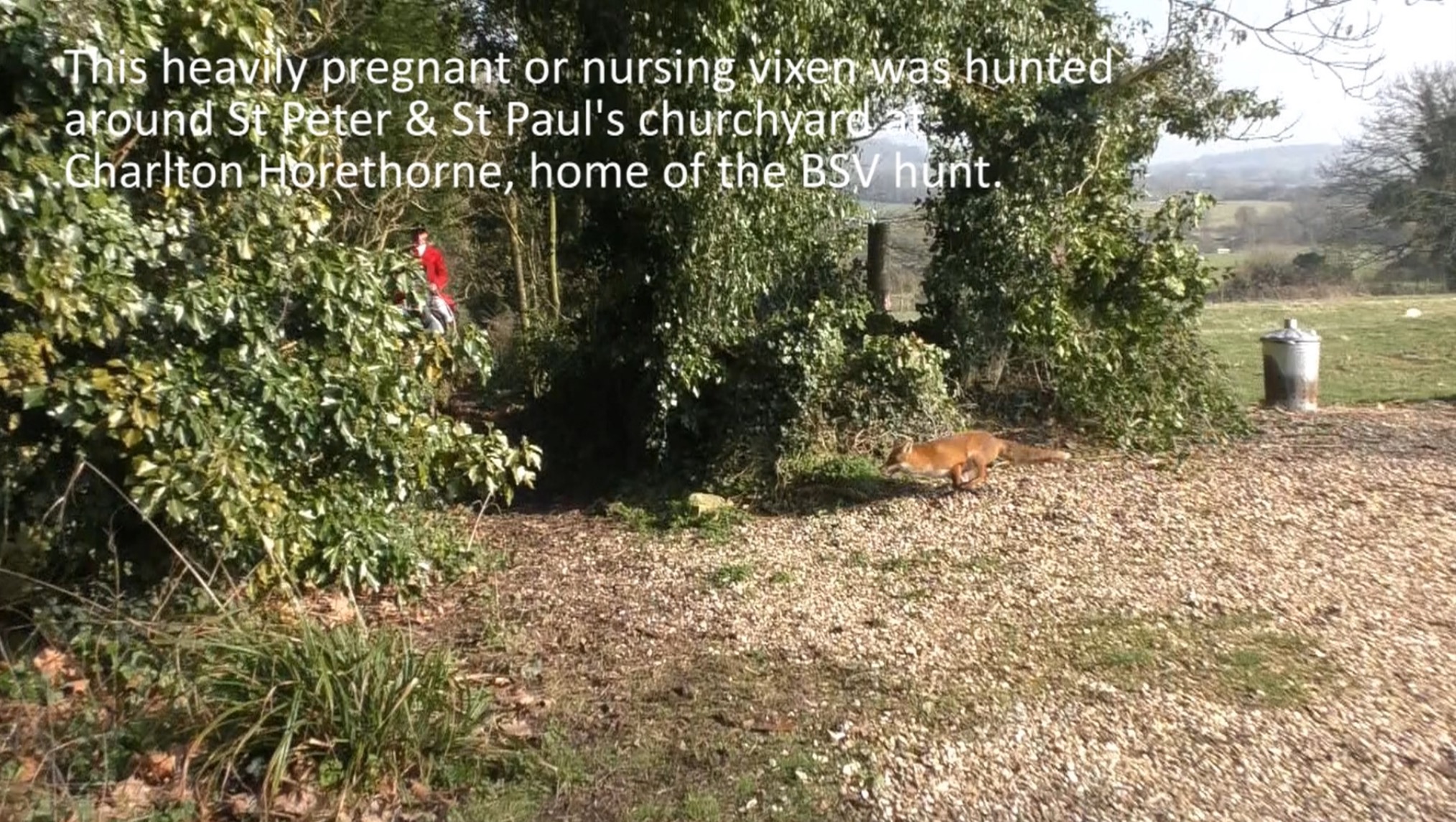 On 23.02.19 the Blackmore & Sparkford Vale Hunt were forced to call their hounds off a lactating vixen in a Somerset churchyard by Monitors who were at the scene. Responsibility for disturbing and hunting the fox rests completely with the hunters. © Somerset Wildlife Crime/Hounds Off
On 23.02.19 the Blackmore & Sparkford Vale Hunt were forced to call their hounds off a lactating vixen in a Somerset churchyard by Monitors who were at the scene. Responsibility for disturbing and hunting the fox rests completely with the hunters. © Somerset Wildlife Crime/Hounds Off
Regarding the recent incident involving the Blackmore & Sparkford Vale Hunt chasing a lactating vixen in a Somerset churchyard, a member of the public contacted the Hunt and asked them to explain why they were hunting a fox when foxhunting is illegal. She received the email we reproduce, below:
From: B&SV Secretary <bsvsecretary@XXXXXXXXX>
To: XXXXXX
Sent: Fri, 8 Mar 2019 19:10
Subject: Re: Recent footage of vixen being chased in graveyard
Dear Mrs XXXXXXXX,
Thank you for your email. The Blackmore and Sparkford Vale is committed to hunting within the law and does so through laying trails by people on horseback, on foot and on quad bikes. Occasionally as we progress through the countryside foxes and deer jump out in front of the hounds and if they deviate from the laid trail then we stop them at the earliest moment. We also have to contend with a number of anti-hunting activists watching us and trying to intimidate. Their tactics employed include spraying other scent on the ground, blowing horns and shouting to distract our hounds, which in turn confuses our hounds and renders our ability to control them that much more challenging. We believe that the film taken is not genuine and is deliberately constructed to discredit us, however clearly we would not normally be hunting anywhere near a graveyard and regret that the actions by the anti-hunting activists caused some hounds to go through the church grounds.
Kevin Hill (tel: 07971 633182) was one of the Hounds Off/Somerset Wildlife Crime team who witnessed and filmed the Charlton Horethorn incident. Kevin is one of the most experienced Hunt Monitors in the country with nearly 40 years under his belt. We asked him to comment on the excuses made by the Hunt:
- As demonstrated in the video from the Charleton Horethorne churchyard, Blackmore and Sparkford Vale Hunt staff seem to exercise selective control over their hounds. They can control hounds very effectively when it suits them.
- Monitors present witnessed the hounds being hunted on to a fox under the supervision of hunt staff. There were no attempts to draw them out of the cemetery or away from the fox which was clearly visible and holloa’d by several hunters and supporters.
- Hunt staff only exercised adequate control over their hounds when asked by one of the Monitors present to call them off the hunted vixen. When faced with two video cameras the Whipper-In (second in command to the Huntsman) was left with little choice but to comply. This proved to be the vital moment that saved the vixens life.
- We do not accept that the presence of any anti hunt Monitors would prevent hounds from being controlled efficiently. This is especially true when hounds are in close proximity to the Huntsman or Whipper-In, as was the case in this incident.
- No hunt saboteurs were present in the cemetery or immediate area on the 23rd February, when this incident happened.
- Footage is available that shows the Monitors present made no attempt to disrupt hounds with any calls, voice or horn and no scent dulling sprays were utilised. Claims to the contrary are merely an attempt by the hunt to dilute the validity of any allegations against them.
- We invite the Blackmore and Sparkford Vale to comment in detail as to exactly what the allegations laid against the Monitors who were present are. We would be most interested to see any footage to support any claims that hounds were called into the cemetery.
- As Monitors we maintain a passive presence with the hunt throughout the day and film proceedings. This can be useful on an evidential basis of any trespass or illegal hunting. As proven on the 23rd February in Charlton Horethorne, filming can often serve to save life when the hounds would otherwise be permitted to continue hunting unhindered. Our footage is available to be viewed here. It is worth noting that a member of hunt staff in a red coat is seen observing the hounds in the cemetery from the road side and makes no efforts to call them out.
Read our original Press Release here.
Footage of the Blackmore & Sparkford Vale Hunt chasing a fox at Folke Church in Dorset on 22.12.18 can be viewed here.
Hounds Off/Somerset Wildlife Crime, without prejudice
13th March 2019
Locals Against the Weston and Banwell Harriers
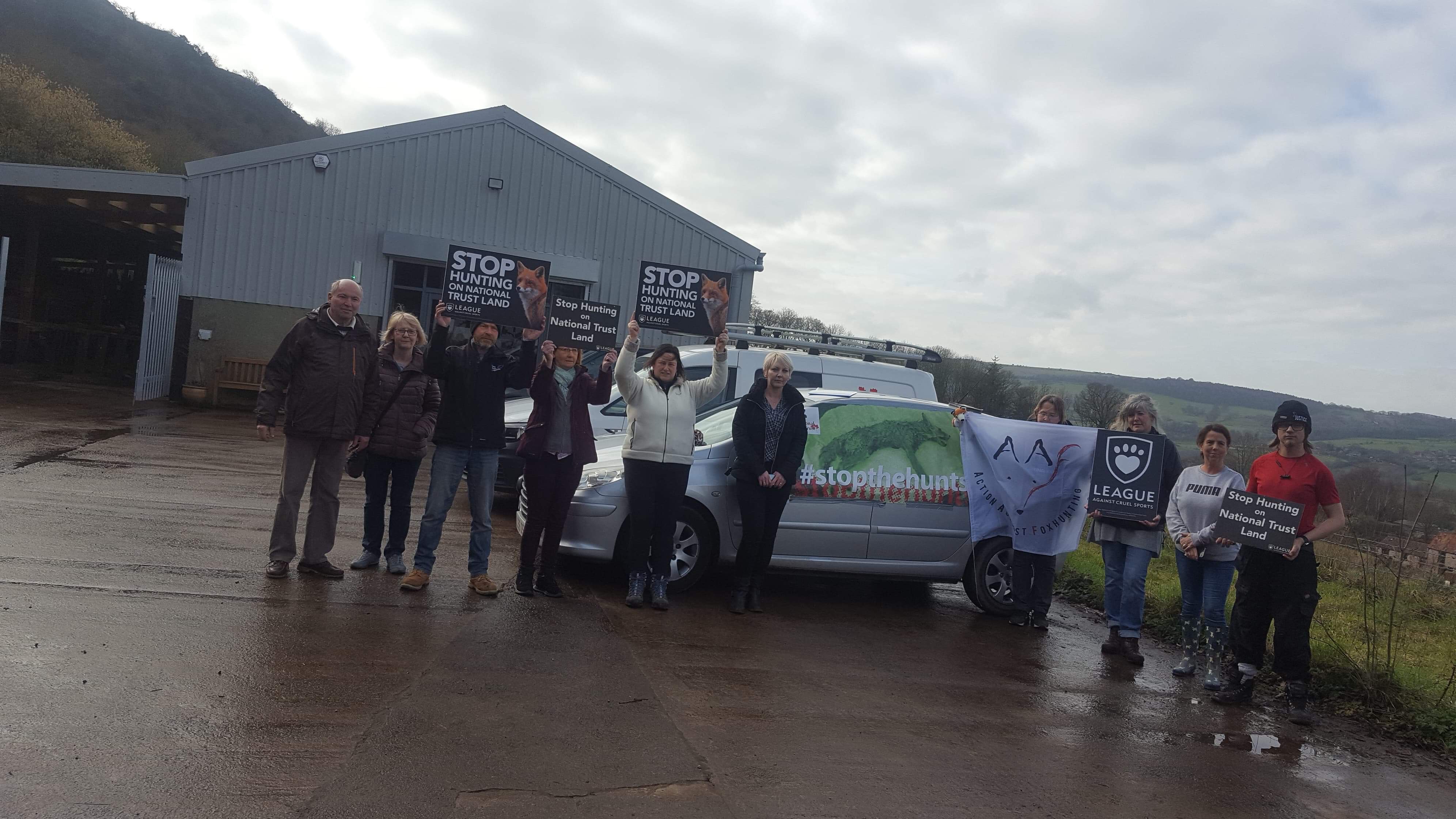 Locals Against the Weston and Banwell Harriers outside National Trust offices at Crooked Peak, Somerset on Friday 1st April 2019. Photo © Locals Against the Weston and Banwell Harriers.
Locals Against the Weston and Banwell Harriers outside National Trust offices at Crooked Peak, Somerset on Friday 1st April 2019. Photo © Locals Against the Weston and Banwell Harriers.
The Weston and Banwell Harriers are a furtive bunch of hunters operating southwest of Bristol. The way they carry on is suspicious to say the least. For instance, why would a legal hunt be involved with blocking badger setts? Consequently, local residents have been trying to persuade the National Trust to withdraw their permission for so-called trailhunting on land which by definition should provide a sanctuary for wildlife.
Locals Against the Weston and Banwell Harriers met with National Trust staff on Friday March 1st. Afterwards, we asked them to let us know their thoughts;
“We attended with Maria Burt who started a petition against so-called trailhunting on National Trust land and set up the meeting, and Jac Freeman from the League Against Cruel Sports. We knew going into the meeting that there was a big likelihood that the licence wouldn’t be revoked but we wanted to give our best shot anyway for the wildlife that calls Wavering Down its home.
“With all our evidence in hand we explained to Nick Droy (National Trust Trailhunting Manager) and the National Trust Wavering Down Team that we didn’t believe the Weston & Banwell Harriers would stay in the rules of the trail hunting licence as they had already sett blocked once this year.
“But sadly and frustratingly this went over their heads and they used the usual excuse that a lot of money had been invested into trail hunt monitoring on their land.
“Giving a hunt notice that they will be monitored just means that they will behave when being monitored by the National Trust.
“How a conservation organisation can support hunting that can and will damage our ecosystem baffles us.
“But our determination to make Wavering Down and Somerset a safe haven for wildlife will continue.
“Hunting is a cruel out of date past time that has no place and is not welcomed. And neither are the Weston and Banwell Harriers, who have been terrorising our wildlife for years unchallenged. Our main aim is to bring an end to this and show them some resistance. We will do all we can to stop them needlessly killing wildlife for sport and fun!
“A big thank you again to everyone that came Friday your support was amazing! And a big thank you to the National Dis-Trust for all the advice and guidance!
“For our wildlife always.”
https://www.facebook.com/localsagainstwestonandbanwellharriers/
Hotline number: 07946663765
Email: [email protected]
© Locals Against the Weston and Banwell Harriers
25th February 2019
Lactating Fox Hunted In Somerset Churchyard 23.02.19
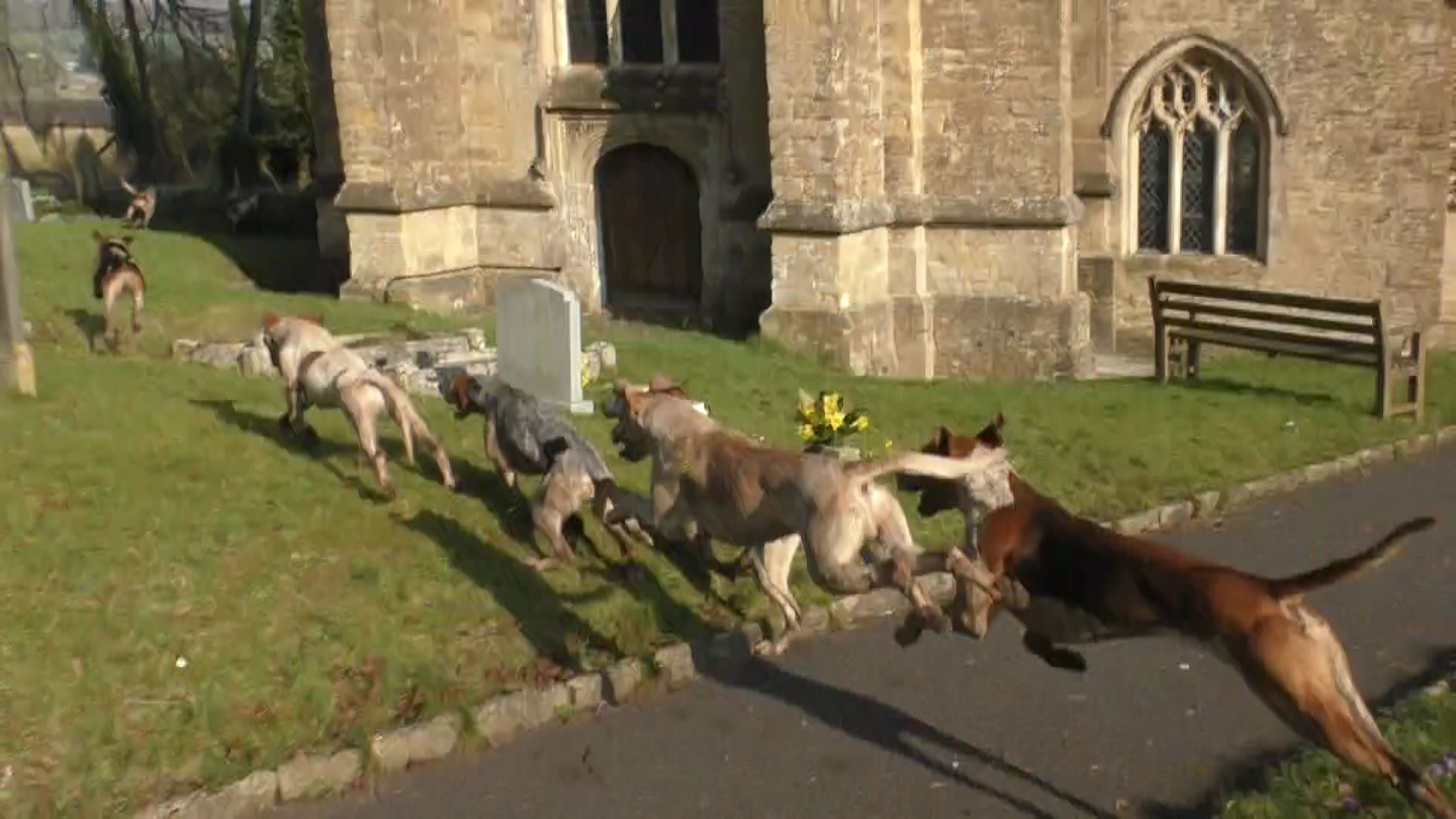 Blackmore & Sparkford Vale Hunt hounds hot on the trail of a nursing vixen in St Peter & St Paul's Churchyard, Charlton Horethorne, Somerset on 23.02.19 Photo: Kevin Hill/Hounds Off/Somerset Wildlife Crime
Blackmore & Sparkford Vale Hunt hounds hot on the trail of a nursing vixen in St Peter & St Paul's Churchyard, Charlton Horethorne, Somerset on 23.02.19 Photo: Kevin Hill/Hounds Off/Somerset Wildlife Crime
HOUNDS OFF PRESS RELEASE MON 25 FEBRUARY 2019
- Hunters in Somerset were forced to call their hounds off a female fox because anti hunt monitors recorded the whole incident on film.
- At about 2pm on Saturday 23 February 2019 the Blackmore & Sparkford Vale Hunt chased the vixen through private gardens and the churchyard of St Peter & St Paul’s in Charlton Horethorne, just a stones throw from the hunt kennels. But Somerset Wildlife Crime and Hounds Off Monitors, equipped with video cameras, were at the scene and recorded it.
- Wildlife rescue expert Penny Little (tel: 07702 565598) reviewed their footage. She said, “I am confident this hunted fox is a vixen that has recently given birth to cubs as her teats are visible and show clear evidence of lactation.”
- WATCH SOMERSET WILDLIFE CRIME / HOUNDS OFF FILM HERE
- Footage shows a fox being hunted through gravestones and into bushes where by some miracle it gives chasing dogs the slip. Campaigners film also documents the moment when the nursing vixen tries to steal away unseen and is “hollered” by a member of the hunt (a loud, high-pitched yell to inform the Huntsman and his hounds that the fox has been spotted).
- Bobbie Armstrong (tel: 07572 495309) from Somerset Wildlife Crime said, “When the fox crossed in front of us we told a red-coated hunter to call hounds off. At this point they were right on her and it looked grim but the red-coat knew we had it all on film. He had little choice but to call hounds back and let the fox get away. It was all a bit tense for a while but we were pleased to be in the right place at the right time.”
- Foxhunting has been illegal in England and Wales since 2005 but hunts continue, claiming to chase a trail which they lay in advance. The “accidental” hunting and killing of foxes during so-called ‘trail hunts’ is commonplace and the law remains powerless to prevent this.
- Hunt Monitor Kevin Hill (tel: 07971 633182) said, “It seems pretty obvious that the Blackmore & Sparkford Vale Hunt were cheerfully and deliberately chasing foxes on Saturday and if we had not been there then they’d have got away with it. Think about it for a second. Who in their right mind would lay a trail through private gardens and a churchyard?”
- Bobbie Armstrong said she had spoken to the Reverend Sarah Godfrey, the Vicar at Charlton Horethorne. According to Ms Armstrong, “She wasn’t aware of the events of yesterday and was keen to see our evidence. The Vicar was grateful to be informed.”
- Hounds Off specialises in giving help, support and advice to farmers, landowners and rural residents affected by hunt trespass. Joe Hashman, Founder, said, “We can help the Reverend Godfrey if she wants to make the churchyard into a hunt-free wildlife sanctuary. All she needs to do is visit the Action & Advice pages of our website or ask us. The same goes for anyone else, anywhere in the country.”
- Somerset Wildlife Crime and Hounds Off Monitors did not see anyone laying trails, or even pretending to lay trails, at any time throughout the day.
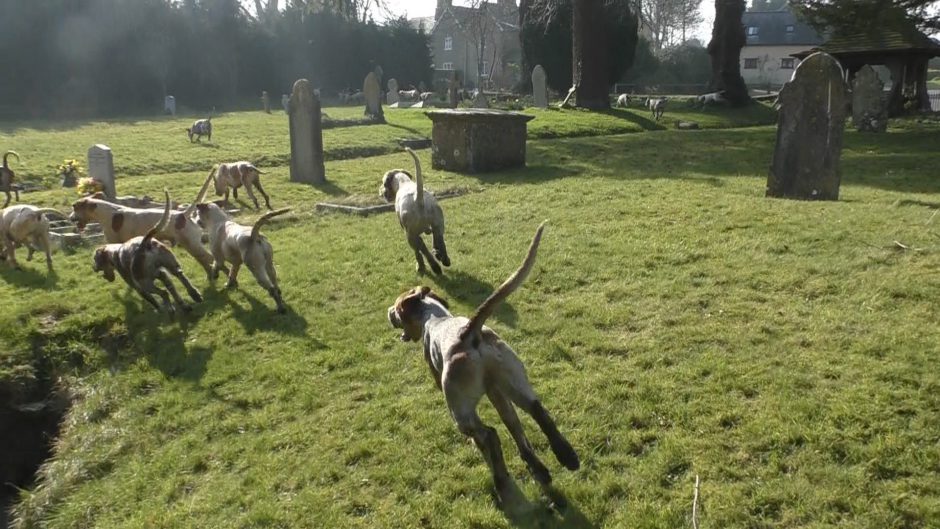
Blackmore & Sparkford Vale Hunt hounds invade St Peter & St Paul’s Churchyard in Charlton Horethorne on 23.02.19 in persuit of a live fox. Photo: Kevin Hill/Hounds Off/Somerset Wildlife Crime
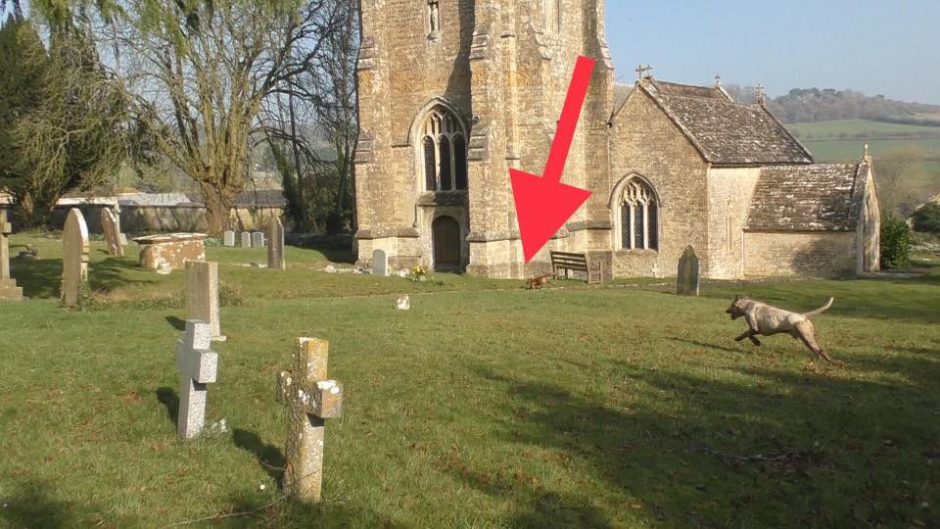
Fox is chased with dogs across St Peter & St Paul’s Churchyard in Charlton Horethorne, Somerset, 23.02.19 by the Blackmore & Sparkford Vale Hunt. Photo: Kevin Hill/Hounds Off/Somerset Wildlife Crime
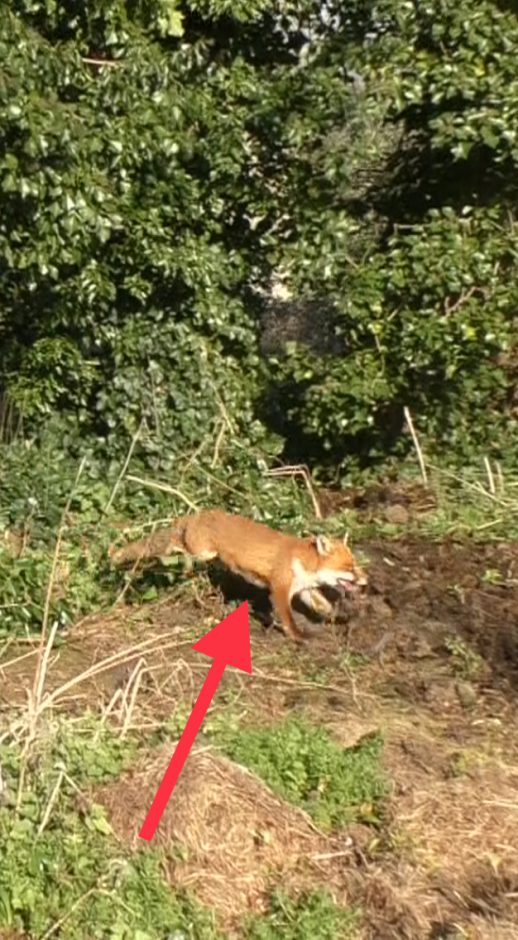
A significant undercarriage is a telltale sign that this hunted vixen was nursing young cubs underground nearby. Photo: Kevin Hill/Hounds Off/Somerset Wildlife Crime
NOTES
In recent weeks the Blackmore & Sparkford Vale Hunt;
- was supposedly ‘trailhunting’ beside and across the busy A352 until after dark on February 19 2019.
- killed a fox ‘accidentally’ on February 9 2019.
- carried on hunting with horses and hounds two days after equine flu was confirmed at a local riding stables.
IF YOU WOULD LIKE TO SUPPORT OUR WORK PLEASE BUY US A KO-FI;
- Somerset Wildlife Crime
- Hounds Off
16th February 2019
Staghunters Break Convention To Ensure Valentines Day Sport
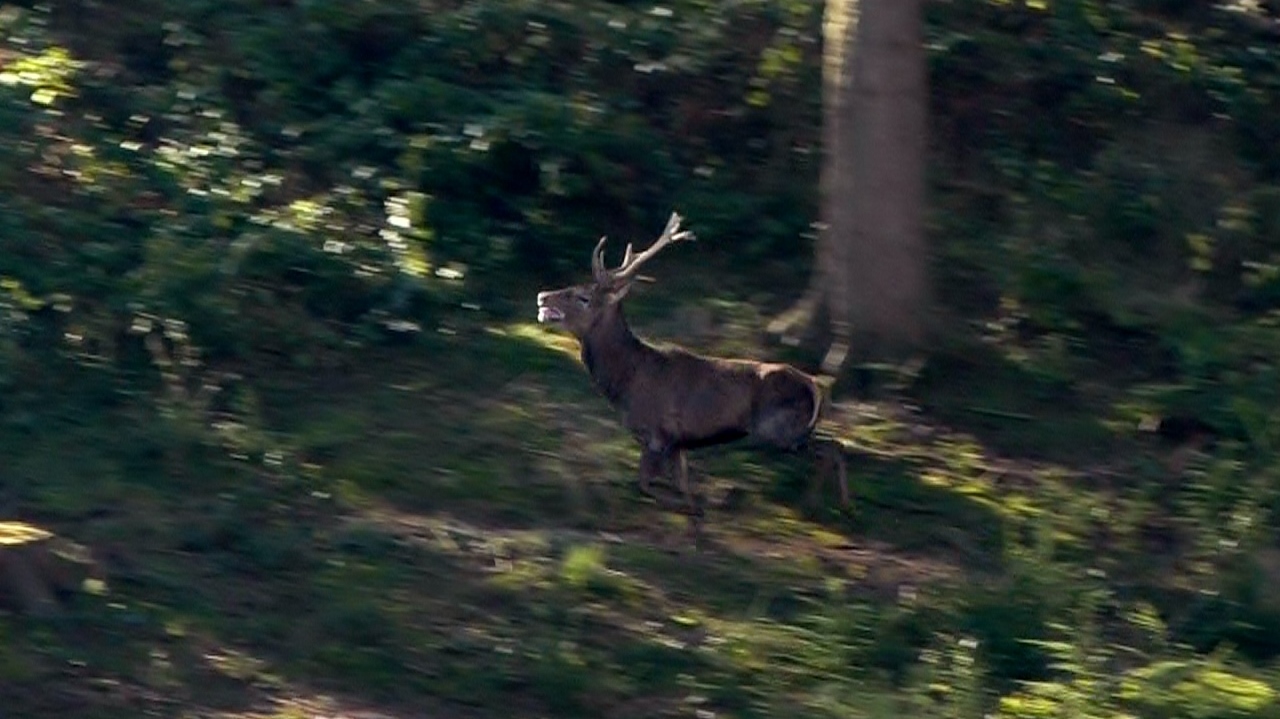 Hunted by the Quantock Stag Hounds on Valentines Day 2019. With no female deer (hinds) in the area, hunters told us this animal was selected because it had a "displaced hip". We question the honesty of their claim because this stag ran for miles across open country and escaped to see another day. Read more, below. Photo: © Kevin Hill/Hounds Off
Hunted by the Quantock Stag Hounds on Valentines Day 2019. With no female deer (hinds) in the area, hunters told us this animal was selected because it had a "displaced hip". We question the honesty of their claim because this stag ran for miles across open country and escaped to see another day. Read more, below. Photo: © Kevin Hill/Hounds Off
Hunters claims that a Red deer stag chased by the Quantock Stag Hounds on Valentines Day was suffering from hip displacement have been seriously questioned by observers. The creature was chased for over two miles as the crow flies, many more as they ran, between 1.30pm and 3.30pm. In the moments before the hunt ended, huntsman and hounds were seen to be fruitlessly trying to find the stag in field hedges near the West Somerset village of Clatworthy.
Experienced Hunt Monitor Kevin Hill, who was part of a team of volunteers from Somerset Wildlife Crime and Hounds Off, filmed the allegedly injured stag in the old slate quarry woods below Brompton Ralph. He said, “The stag looked in good shape to me. He travelled through the woods jumping felled trees!”
The claim that the stag was injured was made to Mr Hill by hunt followers when he asked them why a male Red deer was being pursued at a time of year when females are the traditional target.
Somerset Wildlife Crime and Hounds Off Monitors believe that this was just an excuse because the hunt couldn’t find any females to chase. They only saw stags, roe deer and a fox roused into flight by hounds. That hinds are quarry from November through February is just hunting convention and, on this occasion, in order to get some ‘sport’ it had to be broken.
© Joe Hashman
Support what we do? Keep our service sustainable & volunteers in the field - buy us a Ko-Fi;
Hounds Off
Somerset Wildlife Crime
30th November 2018
Another Wretched Day With The Quantock Stag Hounds
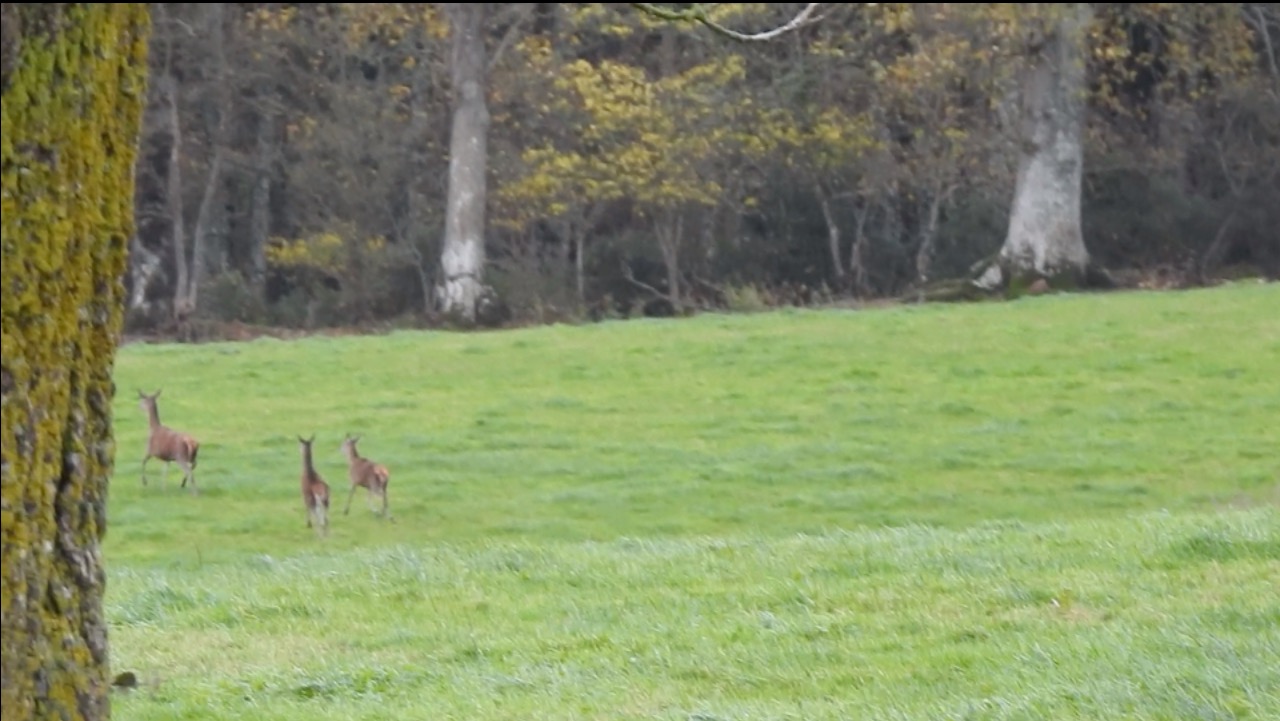 Confused and frightened, Red deer hinds which were hunted by the Quantock Stag Hounds on Thursday 29 November 2018. Stills grab courtesy: Somerset Wildlife Crime
Confused and frightened, Red deer hinds which were hunted by the Quantock Stag Hounds on Thursday 29 November 2018. Stills grab courtesy: Somerset Wildlife Crime
From November through February deer hunters turn their attention, dogs and guns onto the females of the species. Red deer ‘hinds’ become the target. Often the hunt is little more than a shooting frenzy with multiple animals hounded then blasted. This was the case yesterday (29.11.18). I don’t know how many deer were killed by the Quantock Stag Hounds because most of their dirty work was hidden deep in private woods, but before midday I’d heard four gunshots. In the afternoon, two more deer were definitely taken and another possible before everyone dispersed and the Huntsman led seven hounds along the lanes back to their kennels. There seems to be less ritual afterwards. Maybe hinds don’t hold the allure of a majestic, beaten, stag. There are certainly less trophies to be had. You can cut off and mount the feet (known as ‘slots’) and pull out the teeth for ornaments but most hunt followers have plenty of these things already.
For us it was a difficult day and horrid. That said, we got some useful film which will help us continue to shine a light on this disgusting pastime, so I’m holding on to that. Some of it can be seen here.
At this time of year hinds might be pregnant, running with a first year calf still in tow, or both. They’re herd animals and like to stay close to home. So no long chases over miles of countryside here. Everything is much more contained as the deer run around in big circles, trying to shake off the hounds and dodge the bullets which can be around any corner or behind any tree.
In the interests of crop protection The Hunting Act (2004) permits the flushing of deer with two hounds providing that -
(a) reasonable steps are taken for the purpose of ensuring that as soon as possible after being found or flushed out the wild mammal is shot dead by a competent person, and
(b) in particular, each dog used in the stalking or flushing out is kept under sufficiently close control to ensure that it does not prevent or obstruct achievement of the objective in paragraph (a).
Sadly, the wording is sufficiently vague to enable versions of stag, and now hind, hunting to continue which satisfies the bestial urges in a minority of country ladies and gentlemen and leaves the rest of us sickened and confused.
Special thanks to fellow volunteers from Hounds Off and Somerset Wildlife Crime. Thanks also to everyone who supports our work. We could not do this without your backing. If you’re able, please consider making a contribution towards our campaign running costs.
Somerset Wildlife Crime donate here
Hounds Off
Stag hunting in Somerset, October 2018 watch here
© Joe Hashman
30th October 2018
PRESS RELEASE: Stag hunting in Somerset Oct 2018
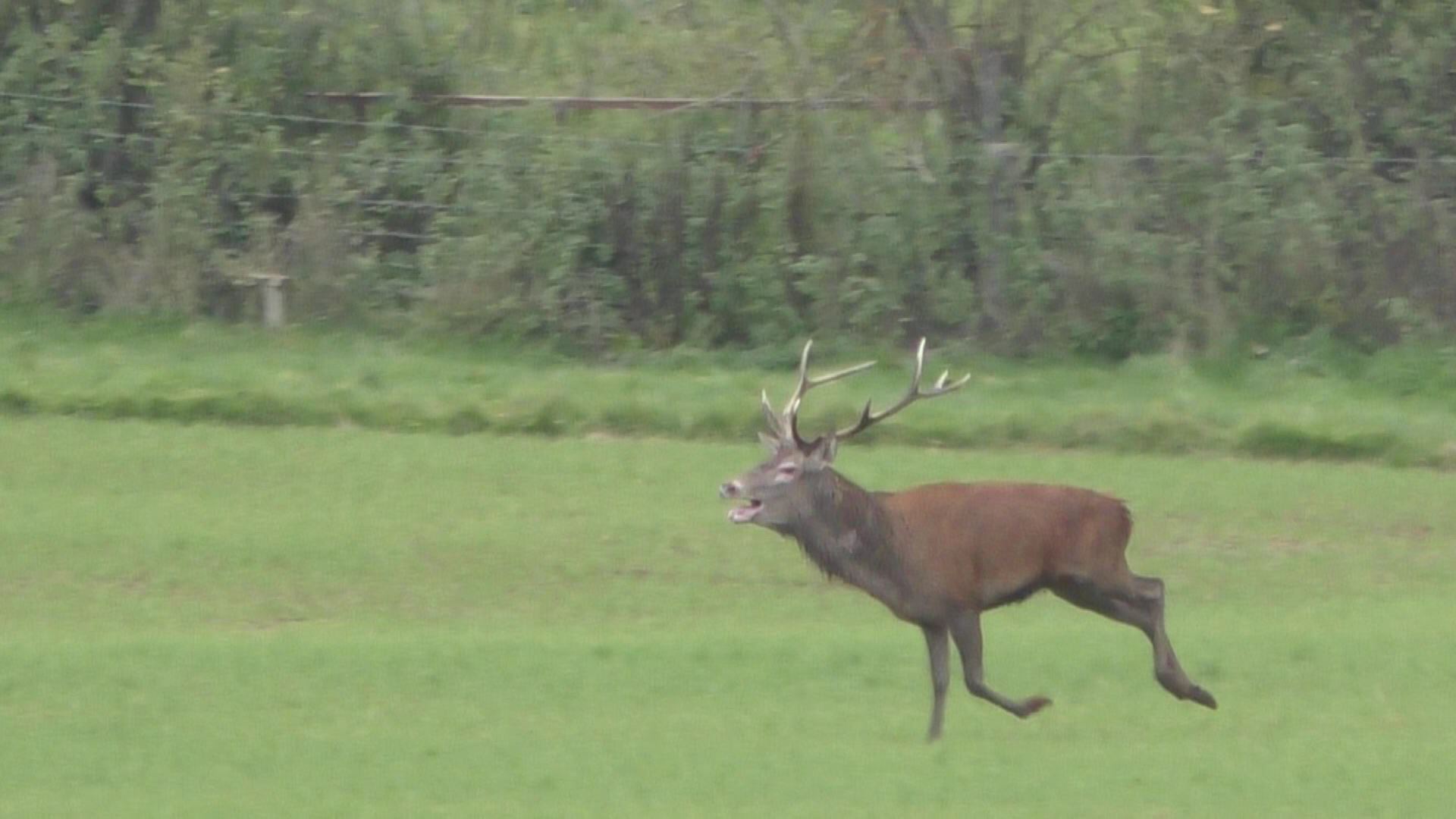 Hunted stag runs for his life. Quantock Stag Hounds, 25.10.18
Photo credit: Hounds Off
Hunted stag runs for his life. Quantock Stag Hounds, 25.10.18
Photo credit: Hounds Off
SHOCKING FOOTAGE EMERGES OF STAG HUNTING JUST TEN MILES FROM TAUNTON
- Campaigners have released shocking footage of a Red deer stag being hunted by the Quantock Stag Hounds in Somerset on Thursday 25 October 2018.
- The hunt took place about ten miles from Taunton near the picturesque West Somerset Railway line at Crowcombe Heathfield and lasted for three hours.
- Hunters used combination of horse riders, dogs and four wheel drive vehicles to harass and harry the stag through woods for nearly two hours before forcing him out into the open, and on his own, for another hour.
- After being flushed from the woods, film clearly shows the stag running with his mouth gasping and tongue lolling. There is a heaviness to his gait.
- About an hour later two hounds, which had been set to follow the stag by scent, have chased him to exhaustion. The stag is ‘at bay’ behind a tree in undergrowth. Hounds can be clearly seen ‘marking’ their target; barking incessantly, rushing forwards and jumping back as the stag uses his antlers to keep them from attacking.
- Gunmen from the Quantock Stag Hounds get within close range but the stag jumps up and makes a bid to escape. Hounds give chase and five minutes later, away from cameras, the stag is killed.
- Hunt followers and riders gather in the woods for the traditional carve-up, where the body is divided into trophies for people to take away and remember their day.
Many people think that stag hunting was banned when the Hunting Act (2004) made chasing and killing most wild mammals with dogs illegal. But it hasn’t quite worked out like that. Stag hunters in the West Country have reinvented their bloodsport with subtle differences which allow them to exploit loopholes and exemptions which circumvent the law, including;
- Claiming to be conducting Research & Observation according to Schedule 1 (9) of The Hunting Act (2004), in the same way as Japanese and other whaling nations carry on killing under the pretence of scientific research.
- The Research exemption was intended to enable scientists to carry out their studies if they needed dogs to find a wild mammal. But it does not specify that people claiming Research under this exemption have to be scientists, that their research has to be genuine or that it should be non-lethal.
- The Observation part only requires a hunter to be looking at the stag when it is killed.
- Flushing to guns. The Hunting Act (2004) provides for this in Schedule 1 (1), so long as only two hounds are used and the stag is shot as soon as possible.
NOTES FOR EDITORS
- The National Trust banned stag hunting in 1997 after Professor Patrick Bateson published a report which found that hunting deer with hounds inflicted cruelty and distress far beyond anything they might experience in nature.
- Stag hunting was prohibited on Forestry Commission land in 1997 too.
- Campaigners have documented numerous incidents of trespass by the Quantock Stag Hounds on National Trust and Forestry Commission land during September and October 2018.
- The Quantock Stag Hounds hunt deer with dogs Mondays and Thursdays throughout September to April.
For more information or interviews please contact:
Bobbie Armstrong
Somerset Wildlife Crime: 07572495309
Joe Hashman
Hounds Off: 07711 032697
9th October 2018
Staghunting On The Quantock Hills 08.10.18
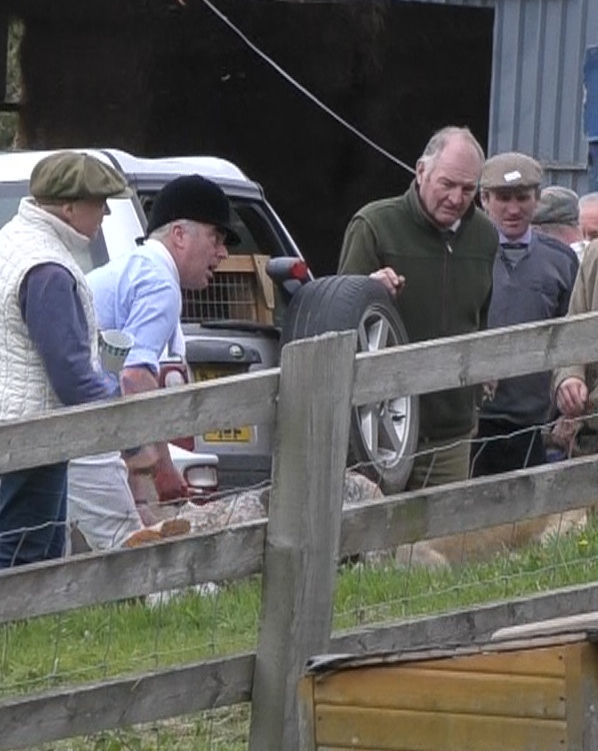 Scene from Quantock Stag Hounds carve up at Staple Farm, West Quantoxhead, Somerset, 8 October 2018.
Scene from Quantock Stag Hounds carve up at Staple Farm, West Quantoxhead, Somerset, 8 October 2018.
There was a moment yesterday when I thought that the Quantock Stag Hounds had decided not to go hunting but alas it wasn’t so. In the end they killed a stag and took the body to a farm to carve it up. Men and women supped cans of drink and watched in gory fascination as the Huntsman, elbow deep in warm blood, dished out bits of inneds and butchered the animal at their feet, in front of their eyes.
They started not far from Bishops Lydiard which itself is a stones throw from Taunton. I was part of a team of Hunt Monitors. We were parked near the beauty spot of Lydiard Hill, by some horseboxes. We anticipated that the Hunt would come in this direction.
Shortly after 11am my radio crackled and the message came through that there was movement our way. Then a gaggle of hunt riders came along the lane, gave us a bit of verbal, loaded their horses into the boxes, and drove off. That was when, fleetingly, I vain hoped they were going to leave stags on the Quantock Hills in peace.
Instead, the Hunt relocated. We got a message that they were up Crowcombe and sure enough that’s where they were hunting.
Staghunting on the Quantocks is not what it was. Prosecutions, campaigning pressure and changing attitudes from the police have forced them to stop using a pack of a dozen or more hounds to chase stags to exhaustion. This season, which started at the end of August, they’ve been using two hounds and an army of riders and vehicle followers to chase and chaperone their quarry. It’s a tactic which staghunters on Exmoor have employed for years now and I think they believe it exempts them from prosecution under the Hunting Act.
There were a couple of huntable stags in Crowcombe Park but an especially big fellow was the target. It took a while for the Hunt to flush him up onto the hills but eventually their pressure forced him out.
I was tracking the Quantock Stag Hounds (QSH) in a vehicle, in communication with others who were both mobile and on foot. From hilltops you get some fantastic views but the Quantock Hills are characterised by large blocks of woodland and numerous steep, deep valleys known as ‘combes’. The staghunters know this landscape intimately and are skilled at operating simultaneously in the open yet out of sight, if that makes sense.
The stag was somewhere below a high spot called Bicknoller Post. Horsemen and women lined the tracks and combe sides. The stag didn’t appear keen to run. It’s mating season for Red deer in Devon and Somerset (the ‘rut’) so likely he was pretty tired from all that. I thought they were going to shoot him there and then but no, they wanted some sport.
What followed was not a high speed, high adrenalin gallop and chase over the countryside. It was more akin to a slow walk. The stag kept low among whatever cover he could find to hide in and the hunters, co-ordinated by radios and aided by their two dogs, pushed the deer along and steered him away from our eyes and camera lenses.
We drove into the picturesque village of Holford. By now we had a hunt supporter tailing us. We waited to let a party of schoolchildren pass. I hoped they saw the anti hunting stickers in the car window and that’s why they smiled and waved and shouted hello as adults in yellow tabbards shepherded them safely to the side. Or, more likely, they were just naturally excited to be exploring such a beautiful place.
A sharp right and left and we were in the car park with dog walkers and tourists. Our hunt tail parked up herself and ran to keep tabs on the foot team we deployed. I drove up a remote, single track lane and at the end was a gathering of elderly hunt supporters in cars.
A number of wooded combes with streams converge at Holford and in the recent past it was a favourite killing place for the QSH. But these days they are no longer Kings of the Hills. They skulk more. Red coats have been swapped for fawny brown. They’re quieter. They still take up a lot of space but they try to avoid clogging villages with four-wheel drives and quad bikes. They are adept at chaperoning their stag quite discreetly away from public gaze.
There were moments while we were in Holford. We heard the hunting horn and urgent, loud shouting. Vehicles travelled at dangerous pace on bumpy lanes back and forth. But nothing more than that came our way.
Our teams of Hunt Monitors communicate by walkie-talkie and telephone, neither of which work well in this area of Somerset. It’s hard to be in the right place at the right time anyway but when communications are poor because the signal isn’t great it’s even harder. We believed that the hunted stag had left the Hills for farmland near Kilve but weren’t sure.
The stag was killed south of the A39 near Kilve late in the afternoon, in the depths of private property, and taken to a nearby farmyard for the post-orgasmic ‘carve up’. They were not happy about us trying to take some pictures and it was difficult anyway as they’d hidden themselves behind buildings. Out of sight but not out of our minds.
That was the bloody reality of staghunting on the Quantock Hills this day, 8th October 2018.
Volunteers from Hounds Off and Somerset Wildlife Crime continue to monitor staghunting on the Quantocks, bear witness and gather evidence to show how hunts are operating. You can . Mark your donation ‘QSH’ and we will dedicate it to this specific fund.
© Joe Hashman
23rd January 2018
Providing Support For Those In Pain & Distress
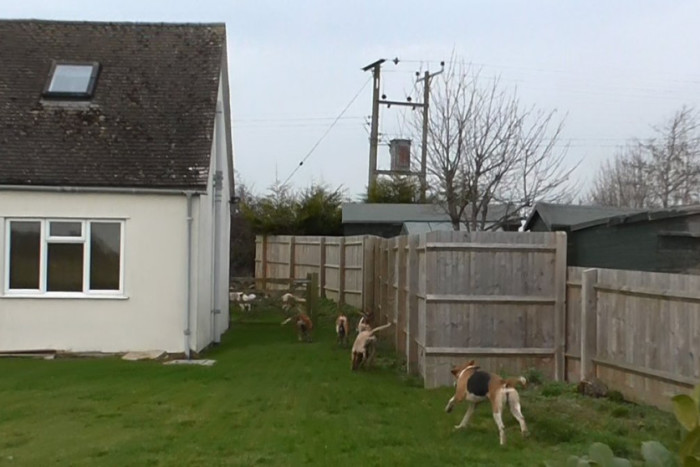 Hounds from the Warwickshire Hunt running out of control in Oxhill near Banbury. Pic credit: West Midlands Hunt Saboteurs
Hounds from the Warwickshire Hunt running out of control in Oxhill near Banbury. Pic credit: West Midlands Hunt Saboteurs
Last week we met a woman who had a foxhunt invade her property. She was still raw from the experience and visibly upset when telling us about it.
The local hunt was in the area and had let their hounds run loose on the scent of a fox. The fox ran into private woodlands with the hounds in hot pursuit. A herd of deer in the woods distracted the hounds and they split up to chase the deer in all directions, then cats, a dog and a goat. The woman and her friends were minding their own business just getting on with their day. Then this bedlam descended, literally, upon them. There weren’t enough broom handles or people to cope and anyway, the hounds were only interested in hunting.
This was no fleeting stampede. It took over an hour for the Huntsman to gather and remove his dogs. By then the police had turned up and were also helping. Two weeks later and six cats are still missing, presumed dead. The others are nervous, shy, frightened. It will take time and tlc to recover their confidence.
The woman was traumatised. She shook as she talked. Her eyes welled up when she described how the peace and tranquillity of her sanctuary exploded with animals running left, right and centre when about twenty-five foxhounds in full cry descended the valley with no warning. She expressed surprise at how big the dogs were and shock at seeing a fox flash past at great pace, running for its life. We explained that, actually, hunts across the land are breaking the law. All the hunters have to do is claim it was an “accident” and they get away with it. She now knows first hand the reality of #TrailHuntLies.
Hunt trespass can have a profound effect on people. It traps some in their homes, fearful to go out on certain days of the week in autumn and winter because they never know if the hunt is going to come crashing through their place. That is no way to live.
Imagine stepping out of your back door and being almost knocked over by rampaging hounds, then having someone sat high up on a horse shouting down at you and gesturing to open your gate so they can come in and fetch them. This actually happened in Dorset and now we keep in close contact with the woman and local police. She is clear and so are we - there must never be a repeat of this.
A young mother who had foxhounds come into her kitchen told her local newspaper, “I am shaken and beyond furious. I can’t bear to even speak to the hunt master who obviously thinks that my home, a haven for my children, is fair hunting ground for their hounds to come and go freely with complete disregard for the safety of my children.”
We watched with interest the evidence of terriermen following a hunt in Devon digging out a fox which hounds had run to ground on Saturday. To most right-minded people it’s an open and shut case but we’ve noted the terriermen’s excuse that they did not intend to kill the fox and were merely rescuing their dog. Without doubt they’ll lay that on as thick as possible and trust in the police to do less than a proper job. It grieves us to write that Devon & Cornwall Police have form. Despite this we’ve helped a number of disgruntled locals who have reported trespass and intimidation by the self-same hunt this last fortnight. We always advise involving the police at the outset, firstly by reporting anything which makes you feel concerned or unsafe and secondly, by cc-ing them in to all correspondence. We always live in hope to be pleasantly surprised.
We’ve been having a conversation with woodland owners in Somerset since December. They’re fed up to the back teeth of having the local hunt ripping through their land and terrorising its human and non-human inhabitants. We’ve arranged to meet later this week. So it was wonderful to receive an email from our contact this morning with details of three neighbouring farms who want to keep hounds off their vast acreages too.
January is always a busy month. We believe this is because it’s the fox mating season. Dog foxes are on the move in search of love. Their wanderings frequently take them far away from of their familiar, home patches. A hunted fox will instinctively bolt down a hole but hunts block all underground refuges and so the fox is forced, against its natural instincts, to keep running. Hunts deny this, of course, but we know the truth.
The above is just a snapshot of what we have going on right now. If you’re affected by hunt trespass or know someone who is then please, contact us. Hounds Off will support you. You are not alone.
You can support our work by or buying some Hounds Off merch. Please consider it. We are all volunteers and cannot survive on goodwill and fresh air alone!
© Joe Hashman
28th May 2017
The Magic Of Hares
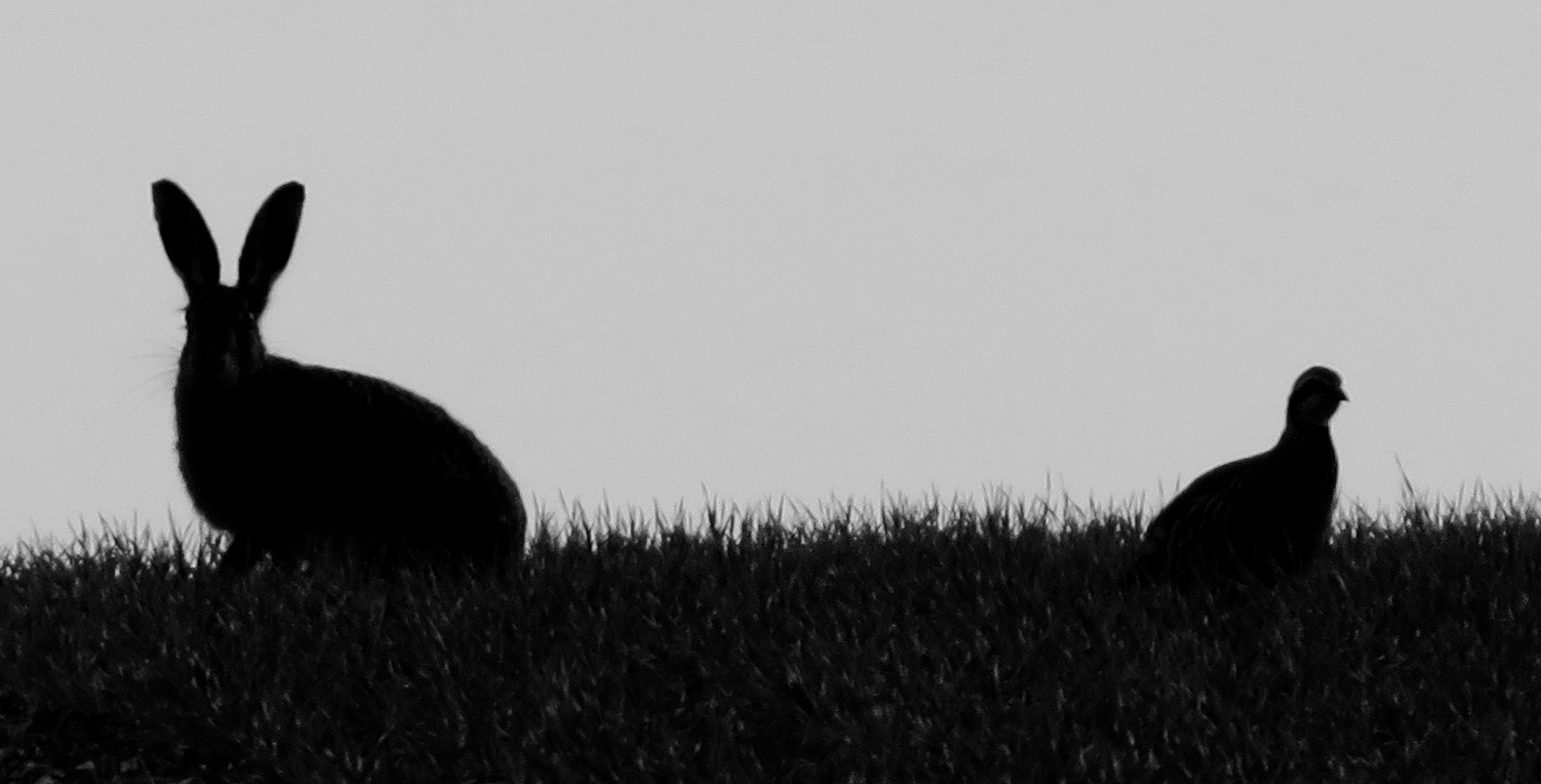 Hounds Off is grateful to Brigit Strawbridge for her permission to use this 2017 photograph.
Hounds Off is grateful to Brigit Strawbridge for her permission to use this 2017 photograph.
The Hare Preservation Trust invited Hounds Off Founder, Joe Hashman, to write the The Magic Of Hares to mark the occasion of their 2017 Annual General Meeting & HareFest which took place at Aldeburgh in Suffolk on Saturday 28 May:
THE MAGIC OF HARES
It’s hard to know how to properly explain what I think about hares.
It’s not enough to say, “They’re amazing creatures, magical, beautiful, I love ’em, look at their ears, those legs, you wanna see them moving, they’ve got wild eyes.” Words don’t adequately convey my feelings towards hares, or how they pull on my heart strings and stir emotions which always feel deep.
I do love hares. I love hares that I see doing their thing in passing fields beyond the windows of a car, I love hunted hares which I worry about and desperately want to escape, and I love all the hares in between.
My first encounter with a live hare was when I was in my early teens, while travelling on a West Oxfordshire backroad to play an evening tennis match. She was large and upright, poised on the tarmac ahead, then gangly but strong, powerful, poetic as she ran.
It was a straight and open stretch of single track lane so we were treated to an extended view. My Mother slowed to an appropriate speed so we could safely but closely see this almost unbelievable creature. Then, in a bound, she was gone, jinking right-handed into the luxuriant verge.
This hare made quite an impression. In that moment her species lept off the butchers shop meat hooks in Oxford’s Covered Market, out from pages of natural history books in the school library, and into my life.
I was upset to learn that hare hunting with dogs was considered to be good sport by people who did it to keep themselves entertained.
AN INTRODUCTION TO HARE HUNTING
My next hare encounter was with the Oxford Polytechnic Hunt Saboteurs Association. They were an effective and experienced bunch. I was a 14-year old local kid but the student hunt sabs took me under their wing in almost parental fashion. They taught me well.
It was early January 1983. We parked in the middle of nowhere and walked cross-country to a remote Buckinghamshire railway hamlet called Verney Junction to catch the Old Berkeley Beagles by surprise. Elderly folk leaning on sticks and gazing into fields gave us clues where the sharp end of the hunt was, and we caught up.
Strange individuals were in charge, running around, blowing a bugle and cracking whips, wearing breeches and riding hats. They controlled a pack of beagles and quartered the sticky plough fields in search of hares to chase. We shadowed them as best we could, using footpaths and avoiding the supporters who were unfriendly and aggressive.
Sometimes a hare would jump up right in front and sprint away. The dogs erupted into mad, unified barking and set off in hot pursuit, using their noses not eyes to follow an invisible scent. The hunters in their breeches, riding hats and green jackets legged after them, and when this happened I learned what to do.
Sooner or later the beagles would ‘check’. This meant they would lose the hares scent and have to refind it. Maybe the hare had doubled back on herself then run off at a sharp angle, or done a huge leap to the side to make it seem like she had just disappeared, or any number of other tricks her species can employ to throw hounds off their backs.
A check allows the Huntsman to catch up and assist his pack. We tried to disrupt the hunt by shouting at the beagles and clapping our hands to make them lift their heads. When their noses were up they were not actively hunting.
One sab in our group had a hunting horn. If we couldn’t get near then this was blown to imitate the Huntsman and confuse the beagles. I could see it worked. They were excited and could be encouraged to come towards us which was perfect if we knew the hare had gone in another direction.
Whenever we saw the hare running we sprayed citronella oil to cover her scent. We sprayed hedges and field edges, wherever we thought a hunted hare might pass or have passed. All the time we were watching, looking for the movement of a small brown hare against a background of naked, thorny hedges and rich, deep plough, trying to keep one step ahead of the hunters and follow in her footsteps, not theirs.
Next week we were on a hillside, sabbing the Old Berkeley again. Beagles were nose-to-the-ground ahead of the Huntsman, searching after a check. We were well placed, discreetly in front and to the side.
The hunted hare broke cover and we dropped to our knees to appear small and unthreatening. The hare ran without a break of stride right passed us, so close you could hear the patter of her feet on the short turf and see into her big, bright, staring eyes.
We sprang into action, spraying citronella, shouting, clapping our hands to distract the excited beagles and get them to raise their heads. We didn’t stop the hunt completely but we did continually delay and disrupt until it got too dark to keep going.
Hares are also hunted on foot with basset hounds. Bassets are very wilful creatures and can appear almost comical in the hunting field. But don’t be fooled. A basset pack which is in the mood to hunt and kill a hare is relentless and deliberately cruel. Whereas the beagler hopes for an ideal hunt of 90 minutes from find to kill, with bassets the duration can be much longer. Hares are evolved to survive with short sharp sprints, not endurance running.
Hunting hares with hounds by scent demands patience, concentration and skill. Sabs developed and employed tactics designed to test all of these to the limit.
The most effective tactic is to take the pack completely. Beagles especially will happily run after nothing at all. They can be encouraged off the line of a hare when they check with appropriate horn and voice calls. Then it’s important to run as fast and far as possible before the hunters can get them back.
Beagles and Bassets are vulnerable to disruption and by 1986 had gone underground. The Shooting Times ceased advertising hunt meets full stop, and the Horse & Hound ‘Hunting Appointments’ section had reduced to a hard core of mounted fox and stag packs.
Luckily, in September 1986 I was given access to an archive pile of Horse & Hound magazines and noted five seasons worth of Old Berkeley Beagles meets.
There were clear and reliable patterns. October meets were nearly identical and then quite predictable for the rest of the season. One or two, like Monks House Farm outside Evenley near Brackley in Northamptonshire, took a bit of working out, but we got it. Lots of meets were held at pubs so a well-thumbed phone book and ringing around with a fake posh accent confirmed most fixtures with uncanny accuracy.
One Wednesday from Botolph Claydon the beagles picked up the line of their quarry early. The hare they were onto chose not to sit and sprint but kept on the move slower and steadier, way out ahead of hunting beagles. Elderly followers would indicate that they had seen her by raising a stick or holding aloft their caps. These signals informed the Huntsman where and when to gently guide his hounds.
It just so happened that the hunted hare and I crossed paths repeatedly during the early afternoon. Whenever this happened I’d put down some citronella and hope to buy her some time. But conditions that day were unhelpful and her scent was strong. Eventually the hunted hare ran towards me, then turned along a hedgeline with the pack on full cry just seconds behind.
The only way to stop them this time was to break cover. I shouted, sprayed and caused as much distraction as possible. Initially it worked. Beagles burst through the other side then lost momentum, lifted their heads and spread. But there were too many and it was too hot for me to handle. I was assaulted by the Field Master but wriggled free and had no choice but to get away as fast as possible to avoid a beating from him and others.
My moped was parked by the church. It stepped-through first time and I rode home at a top speed of 30 miles an hour. It was a traumatic experience which I recounted to my Mum. She listened and said only that, “Hares can sense when you are there and trying to do good.”
In 1986 I was an estate worker for the Berkshire Buckinghamshire & Oxfordshire Naturalists Trust, doing practical woodland and other habitat management. I was an excellent worker; punctual, reliable and keen.
It was quite a shock when the Old Berkeley Beagles Huntsman walked in to the office on the evening of our Christmas party. Turned out he was the North Buckinghamshire Regional Chairman. Early in the New Year I arrived five minutes late for work and was sacked on the spot.
RADLEY COLLEGE BEAGLES
A few public schools keep their own pack of beagles and at these institutions, hare hunting is on the curriculum. One, the Radley College, used to access many of its meets by driving right passed the top of our road. Even younger kids from an Oxford prep school called The Dragon were bussed out twice a week to join them in the countryside and learn how to kill for fun.
In late 1989 at a place called Appleford they hunted a hare into private gardens. Locals were outraged. A petition was launched asking the Radley College Beagles to stop meeting at Appleford and 80% of villagers signed it. The Bursar of Radley College publicly promised “to do everything possible to avoid future problems”, but he wouldn’t commit to dropping the meet at Church Farm.
Two sets of severed hares ears were sent to my parents house through the post so clearly our campaigns were touching a nerve and sabbing on the day saved lives. The importance of non violent direct action cannot be underestimated. But looking back it’s worth considering, with these schoolboys especially, did we win hearts and minds or just make them more stubborn and entrenched?
HARE MEMORIAL DAY
On March 6th 1989 a vigil was held at the Martyrs Memorial in Oxford to remember hares killed by hounds. Over 40 people attended, listened to speakers and held a silence. Afterwards some of us went on to sab the Christchurch & Farley Hill Beagles. This is the Oxford University hunt and, as with the school packs, introduces many outsiders to so-called “fieldsports” and the lifestyle that goes with it.
Students who wanted to go beagling met at Oriel Square in one of the colleges, then got a lift. On Hare Memorial Day we had someone at Oriel Square, working undercover. She called in from a phone box to tell us the meet was at East Hanney. No hares were killed but the police were heavy handed.
I was arrested and charged with possessing an offensive weapon - a hunting whip - and threatening behaviour. In May, Wantage Magistrates Court ruled that the case should be discontinued but in early July I received a summons for non payment of outstanding costs. They were holding me liable for £156 because, technically, the case was never formally dropped. I went straight to the press and a week later Wantage Magistrates Court ruled that it was unfair to expect me to pay costs for a case which never got heard.
On another occasion out with this lot, we were set apon by a gang of local foxhunt thugs. Horns and sprays were stolen, we were assaulted, bloodied and bruised.
Be in no doubt that folk who enjoy killing a creature as timid and harmless as the hare will use any means possible, fair foul or violent, to quieten dissenters.
THE WATERLOO CUP
The Waterloo Cup was a three day festival of hare coursing. In coursing, hares are used as a live lure to test the speed and agility of two fast-running dogs like greyhounds. The Waterloo Cup was a sixty-four dog stake which, by process of elimination, whittled down to a grand final and eventual winner. There was prize money, prestige and the bookies loved it.
The hare coursing season ran from September to March. During that time lots of clubs around the country would hold smaller events of one day, sometimes two. The Waterloo Cup was the peak of the season, bringing together all winners and qualifiers. In its heydays of the late 1800s, crowds of eighty thousand would flock to watch.
The National Coursing Club was the governing body for this sport. They advised spectators not to identify with the hare because doing so might spoil their enjoyment. You have to wonder what kind of sub-human gets their kicks from watching hares running for their lives right before their eyes, sometimes even in and around their feet, twisting and turning, often being caught, frequently being savaged in the jaws of both dogs, almost always having to be killed by a coursing official called a “picker up” who would put the pitiful creature out of this totally unnecessary and extended misery by pulling its neck.
In 1985 the Hunt Saboteurs Association organised its annual disruption of the Waterloo Cup. Previously, terrible violence had been dished out to sabs by coursing supporters so on Day One protesters marched the lanes as close to the coursing fields as possible, always with a heavy police escort.
Day Two was different. Sabs were up before dawn, driving to a secluded spot just beyond the northern fringes of Liverpool in an assortment of battered transit vans and old cars.
Ahead was the River Alt. The location had been identified as a suitable fording place to reach the fields opposite. Later that morning hares would be corralled there so they could be released, one by one, into an arena in front of the dogs and jeering, rowdy crowds.
Gamekeepers encouraged unnaturally high numbers of hares around the West Lancashire village of Great Altcar specifically for coursing purposes. Hares were also imported from other places before this and other big coursing events. It was quite likely that some had recently arrived from the Six Mile Bottom Estate in Cambridgeshire. Sixty-three hares were needed to run the Waterloo Cup itself, and many more to complete the Plate and Purse competitions which ran concurrently. The last thing that coursing officials wanted was a shortage of quarry.
Sabs waded across the river and were organised into long lines which stretched across the fields. I was in one of these lines. There were sabs to both sides at close but regular intervals. Our tactic was to move in unison and shepherd hares out of the danger zone. As we walked, hares were jumping up all over the place. Some tried to dodge between the gaps. We had to create a wall of noise to turn them back.
Soon the police arrived. They emerged from the mist mob-handed and all wearing regulation black wellies. I was grabbed and frogmarched to a waiting mobile police cell which soon filled up. Sixteen of us were tried and found guilty at Ormskirk Magistrates Court of causing Criminal Damage to a field of cabbages. We were bound over to keep the peace. Prosecution witnesses included cops, coursers and their lackeys. They all lied through their teeth so we appealed. I was a minor at the time of the arrests. The Judge at Preston Crown Court granted my appeal alone, on the grounds of being led astray by the grown-ups.
The Waterloo Cup ran for another twenty years but 2005 was to be the last. For all it’s faults, the Hunting Act was unequivocal in making hare coursing illegal.
PALMER MILBURN BEAGLES
Beaglers and their like circumvented the Hunting Act by inventing the false alibi of ‘trail hunting’. They claimed to lay a scent themselves then set their dogs on to that. And because rabbits are not protected by the Hunting Act, they would pretend to be hunting these animals whenever it suited.
Rabbits bolt for a hole at the first sign of danger and are never more than a short dash away. I remember reading one post-ban feature article in the Horse & Hound about a beagle pack in Somerset, and the impossible tale of a “rabbit” that led hunters and their hounds a long and merry circular dance around the cider orchards of West Bradley.
The Palmer Milburn Beagles used trail hunting as a cover for illegal hare hunting in Berkshire and Wiltshire. One of their favourite hunting grounds was Salisbury Plain, a huge area used by the Army for training exercises.
Salisbury Plain mostly comprises vast tracts of open, uncultivated grassland with scattered woods which stretch as far as the eye can see. There are few metalled roads. It can be a desolate and wild place.
In this habitat hares thrive. They are big, wily creatures who enjoy sheltering amid the dips and folds of rough vegetation and dining on an unrivalled selection of naturally occurring seasonal herbs and grasses. For hunters, these hares are prime quarry and for that minority of people who are thrilled by such things, Salisbury Plain is an ideal place for pitting a pack of beagles against hares which are in the peak of physical condition.
For a couple of months during Winter 2006/07 I followed the Palmer Milburn Beagles with my colleague, Shely Bryan. Shely and I worked for the International Fund for Animal Welfare. Our job was to gather evidence of Hunting Act offences for prosecutions.
We had a source for meets on Salisbury Plain so decided to take a look. First time out we pretended to be four-wheel drive enthusiasts who enjoyed muddy rides along the numerous tank tracks and green lanes. Then we pretended to be interested in watching the beagling but were too lazy to get out and walk. Instead we followed in our vehicle. Nobody objected so we spent many days tagging along.
Shely and I used the cover of being in a vehicle to discreetly gather loads of evidence. Our films showed that people were using a pack of beagles to find, chase and kill hares on Ministry of Defense land just as they had before hare hunting was banned. We showed that this was being done repeatedly and deliberately. We got footage of hares being chased by beagles, hunt staff and supporters in that order. We identified the people involved and evidenced other behaviour that was specific to beagling.
One piece of footage showed a hunted hare running below a supporter, then changing direction. A minute later the beagles came along the same line as the hare. Where the hare turned, they checked. The supporter who had seen the hare running below them raised his cap on a stick to show the Huntsman where she had gone and he, in response, got his hounds on the line again.
On one occasion we filmed the beagle pack in full cry some way off. They hunted fast and hard then stopped and sniffed about. We could see the Huntsman nearby in the same area of long grass. Suddenly the beagles all converged really quickly in one place and the Huntsman blew his horn to signal a kill. This was confirmed to Shely and myself by the Whipper-In, who was standing close to our four-wheel drive as we all watched.
“That’s a kill,” she said, then, “Don’t tell anyone I said that, it doesn’t happen.”
We prepared all our evidence properly and handed it to the Military Police in person. We gave them everything they needed for justice to be done, but there were no charges.
At a meeting with the Investigating Officer, he told us that the Huntsman had been called in for interview and claimed that what we said was film of a kill actually showed the beagles pouncing on a packet of biscuits which he had hidden for them in the long grass.
We suspended our disbelief and told the Investigating Officer that it’s illegal to chase hares, you don’t just have to kill them.
But it was too late. The six month window for charges to be brought was just about to elapse and all our cases were effectively dead.
YORKSHIRE ‘GREYHOUND TRIALLING’ (aka HARE COURSING)
The Hunting Act Enforcement Team at IFAW was aware that the coursing community had adopted cosmetic changes to their sport which they hoped would enable them to defeat the law as well. When we received information that a post-ban version of the Waterloo Cup was to be run near Malton in Yorkshire in March 2007, Shely Bryan and I were sent to investigate.
For this job we used a camera hidden in binoculars and a pinhole camera worn on the lapel. I was on the binoculars. They were a brilliant piece of kit which allowed targeted, covert filming to take place whilst standing in the thick of it.
The evidence we gathered over two days of competition secured convictions of two landowners plus celebrity chef Clarissa Dickson-Wright and hare coursing officianado Sir Mark Prescott.
The landowners claimed that they were hosting a new sport called Greyhound Trialling. In reality the only difference between this and pre-ban hare coursing was that the dogs wore muzzles and a length of orange barrier netting was staked up some distance opposite to where the hare and dogs started from. It was no barrier. More often than not hares would flee to either side. If they could keep going long enough the greyhounds would tire and stop. Sometimes the hare ran out of sight, followed by greyhounds and then their puffing, blowing, lumbering trainers.
With the binocular camera we shot film of a hare being pinned down against a wire fence and pummelled by the muzzled jaws of the dogs before the picker-up got there, wrestled the hare and killed it by grabbing the ears and feet and pulling in opposite directions.
These convictions at Scarborough Magistrates Court in July and September 2009 augmented those achieved by us in partnership with the the RSPCA and League Against Cruel Sports at Kings Lynn Magistrates Court in December 2008, following a Joint Operation on an event at Great Massingham in Norfolk.
We exposed Greyhound Trialling as a sham, well and truly. Word on the rural grapevine was that we had finished organised club coursing with these court cases.
I’d like to believe that this is still the situation. But we would be unwise to take such things for granted. History shows that bloodsports fanatics should never be trusted.
HOUNDS OFF
In Spring 2010 a Tory landslide at the upcoming General Election seemed imminent and I was really worried that this would jeopardise the future of the Hunting Act. I was determined to find a way of stopping hunting which would work effectively, regardless of the state of the law.
The idea of creating a network of wildlife sanctuaries, where landowners prohibited hunting on their property, made a lot of sense. I was familiar with League sanctuaries in the West Country and the way these once worked to scupper hunting.
I also remembered how hard the bloodsports community fought in the mid 1990s to overturn County Council bans because these had a real and negative effect on hunting across the country.
And I was inspired by locals from Elcombe in Gloucestershire. There, the Cotswold Hunt was once a frequent and unwelcome visitor. In 2006 residents organised themselves. They engaged with Stroud Council and the Police to try and get an ASBO against the hunt. Matters didn’t get quite that far but the Cotswold Hunt did receive an official warning under the 2003 Anti Social Behaviour Act and the problems stopped.
The fact is that if you take away land you take away hunting opportunities.
Friends, family and colleagues at IFAW helped to crystallise this thinking and in September 2011 a campaign was launched called Hounds Off.
The original mission was two-pronged;
First, to provide online resources specifically designed to help people to protect their property, livestock and pets from hunt trespass.
Second, to support the 2004 Hunting Act.
During the 2011/12 hunting season Hounds Off dealt with twenty-six complaints of hunt trespass. In 2016 this had risen to ninety-four cases of trespass and havoc by seventy-three different Hunts across the UK.
Last November a woman contacted Hounds Off. She had experienced a pack of beagles chasing a hare through her garden. She was upset about illegal hunting and also that a fence had been damaged. She told us the Beagle Master visited after the incident to reassure her that they were not hunting illegally. Apparently the hares they were chasing were “already injured” so the dogs were being used to execute mercy killings. The woman who had her Saturday afternoon ruined by hunt trespass and lies was seeking advice and support.
The first thing we did was help her to secure her property against future hunt trespass incidents using the ‘Hounds Off Belt & Braces Approach’. This is the standard action which we have encouraged and supported hundreds of people like this woman to do. It’s part of a suite of resources to be found on our website and can be implemented by anyone.
The next matter to address was the broken fence. We were able to provide the information needed so this hunt could be contacted and asked to pay the bill for damage repairs.
The third aspect we considered was the illegal hunting of hares. You see, it’s true that the Hunting Act does include an exemption which allows for the use of two hounds in dispatching genuinely wounded quarry. But if this exemption is claimed then it’s a condition that no more than two dogs are used and that those dogs must be under control.
Make no mistake, I’ve no doubt that this beagle pack was deliberately hunting healthy hares.
But who is going to pursue this? Who’s going to hold the hunters to account? The police are mostly indifferent and the big anti hunting charities have their own agendas.
Sadly at the moment, Hounds Off doesn’t have the resources to do it. We operate with volunteers, in personal time and with minimal funds. But we are always learning, always growing, always developing. And we have vision. Right now, we are establishing a specialist legal team which can advocate for the woman who contacted us to ask for help, and for the hare.
Last year the Hare Preservation Trust got in touch. They wanted to see hare hunting and coursing represented on the downloadable No Hunting poster which is available on www.houndsoff.co.uk . We agreed it was a great idea and if they stumped up the neccasary pence, we would make it happen.
The ‘Hounds Off Our Hares’ logo was launched last Spring. We made No Hunting & Coursing posters available and promoted a limited edition offer on merchandise which engaged lots of people, raised awareness and helped us to cover costs.
Once again, the Hunting Act is in danger. As in 2010, there is the very real prospect of a big Tory majority in the House of Commons after the upcoming General Election, and subsequent move by bloodsports apologists at Repeal.
I’m aware that here in Suffolk you have ongoing issues with illegal hare hunting by harrier packs and a brick wall of institutional corruption within Suffolk Police.
In darker moments it can all feel too much, too heavy, too painful. But these dark moments pass. The hunted hare must remain alert and strong if she is to survive and see tomorrow, and so must we.
There has never been a more important time to stop hunting where you live. Every farm, every field, every garden, every backyard, every community greenspace, everywhere counts. Please please please, use www.houndsoff.co.uk as a resource to help you do this. Share this website with your family, colleagues and friends.
Hounds Off is the people’s campaign against hunting and the beauty is that, to succeed, we need rely on no-one but ourselves.
“THE STAG OF THE STUBBLE”
I would like to finish by reading a piece I wrote on August 12th 2009;
“Harvests are coming in from the fields. The shape and texture of our landscape is changing again.
“I travelled back from the other side of Salisbury at dusk. In the expansive flats east of Fovant, combines were working under the gaze of their own bright lights. Great chuntering machines, spewing chaff in a continual jet of solids funnelled out sideways, gobbling vast swathes of rape, whose aroma filled the air as I passed through, windows down, enjoying the freshness of the Summer evening breeze.
“Somewhere betwixt front cutting blades and the stream of waste, somehow within that huge state-of-the-art monument to human invention and beneath the tiny seated driver, what needed to be done to render a crop useful in the factory was done.
“The combine I saw was literally on the final strait. A single remaining column of standing arable almost swallowed up.
“And so the earth is laid bare again. A naked spread of soil and stalks to be picked over by small birds and, in waxing moonlight, that lolloping, nose-twitching, wide-eyed, ever cautious, perfectly proportioned, ears keen, harming none, built-for-speed, always ready to run, stag of the stubble - the hare.”
© Joe Hashman
May 2017
Editor's picks
- Best Casino Sites Not On Gamstop
- Online Casinos Not On Gamstop
- UK Betting Sites
- UK Online Casinos Not On Gamstop
- Gambling Sites Not On Gamstop
- Non Gamstop Casinos
- Sites Not On Gamstop
- Non Gamstop Casino Sites UK
- Non Gamstop Casino Sites UK
- Non Gamstop Casino Sites UK
- Non Gamstop Casino Sites
- Top Casino Sites UK
- Casino Not On Gamstop
- UK Online Casinos Not On Gamstop
- UK Casino Not On Gamstop
- Casino Sites Not On Gamstop
- UK Casino Sites Not On Gamstop
- UK Online Casinos Not On Gamstop
- Best Betting Sites
- Casinos Not On Gamstop
- Best Non Gamstop Casinos
- Betting Sites Not On Gamstop Uk
- Sites Not On Gamstop

